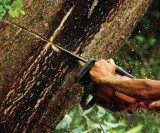How investigating rainforests helped Andy Holmes’ pupils consider their role as global citizens...
 Our rainforest project provoked a strong reaction from the children, and there was an incredible level of engagement from everyone involved. But it wasn’t just the theme that pupils warmed to; the different learning approaches we used played a vital role. We were following the rainforest unit from the International Primary Curriculum, which seeks to develop adaptable, resilient and globallyminded young learners. It certainly broadened our pupils’ horizons, and also presented many opportunities to explore PSHE and Citizenship. Over the course of the project, our children’s debating skills showed a marked improvement. This article covers just some of the ideas we used from the IPC framework, which you might like to try with your own class to give them a taste of this international, personal and academic approach to learning.
Our rainforest project provoked a strong reaction from the children, and there was an incredible level of engagement from everyone involved. But it wasn’t just the theme that pupils warmed to; the different learning approaches we used played a vital role. We were following the rainforest unit from the International Primary Curriculum, which seeks to develop adaptable, resilient and globallyminded young learners. It certainly broadened our pupils’ horizons, and also presented many opportunities to explore PSHE and Citizenship. Over the course of the project, our children’s debating skills showed a marked improvement. This article covers just some of the ideas we used from the IPC framework, which you might like to try with your own class to give them a taste of this international, personal and academic approach to learning.
 To get the project up and running, children should use various sources of information and a variety of art materials to make a large 2D or 3D class display of a rainforest scene. When it is finished, ask the children to reflect on their combined achievements. Are they satisfied with the result? How well did they work as part of a team? You should emphasise how pleased you are with the display, boosting the children’s appreciation of their work.
To get the project up and running, children should use various sources of information and a variety of art materials to make a large 2D or 3D class display of a rainforest scene. When it is finished, ask the children to reflect on their combined achievements. Are they satisfied with the result? How well did they work as part of a team? You should emphasise how pleased you are with the display, boosting the children’s appreciation of their work.
After school, “destroy” the rainforest in some way. How much it is destroyed is up to you. It could be modified so that some plants and animals are removed or covered. You could add pictures of fires, logging trucks, floods, etc and large labels such as ‘Destroyed’, ‘Pollution’, ‘Dead’, ‘Flooded’, ‘Slash’ and ‘Burn’, etc. could be stapled over the children’s display.
The following day, wait for the children’s reactions to the destruction of their rainforest display. Place a tape recorder near the display to record their dismay (this will be used later in the unit). Discuss with the children how they feel about the changes to their display. Why do they think their display has been destroyed in this way?
Isn’t that a bit harsh?
We spent a whole week working on our rainforest display. The children were really proud of their work when it was complete. On Monday, they came in to find that half of the display had been pulled down and there was a picture of a bulldozer and a fire in its place. The children were really upset; we almost had tears, and then they were angry. I could see them starting to realise what had happened and we discussed this as a whole class. It created some very passionate comments and feedback; initially about their own display but then very quickly moving on to their feelings about rainforest destruction. This passion in their beliefs continued throughout the entire six weeks of the unit and has stayed with the children since.
Have a drama or role-play session to debate the destruction of the rainforest. The children should take on the roles of people from various groups who have an interest in the rainforest, e.g. a tribal leader, an exporter, a government official, a mining prospector, an anthropologist, a conservationist, etc.
I chose to split the class into groups and each group took on the role of a different person. At the beginning of the year they had struggled with this idea of representing feelings and beliefs that were contradictory to their own. To help them, I told the children to forget their own thoughts and instead to consider how someone else might think. The more role play they do, the easier it has become and this activity was very successful for looking at the issue of rainforest destruction from lots of different perspectives. It has really helped the children’s debating skills but also developed many personal learning skills including morality, thoughtfulness, respect and cooperation.
 Discuss with the children which rainforest products they think we use in our everyday lives. In small groups, ask your pupils to research and compile a list of any products they can find. A good place to start is http://www.rainforest-alliance.org/resources/dailyuse.html Discuss your findings as a class and show examples of different products. Talk about the contribution of the rainforest to science and medicine. Collate the group research into a class list.
Discuss with the children which rainforest products they think we use in our everyday lives. In small groups, ask your pupils to research and compile a list of any products they can find. A good place to start is http://www.rainforest-alliance.org/resources/dailyuse.html Discuss your findings as a class and show examples of different products. Talk about the contribution of the rainforest to science and medicine. Collate the group research into a class list.
My class was surprised to discover one of the ingredients needed to make chewing gum is only available from the rainforests, as well as many medicines that they use, and everyday foods like bananas and chocolate. This new-found knowledge helped bring the rainforest much closer to home.
Show the children some examples of maps and photographs that highlight the destruction of the rainforest in different regions around the world. How do the children think the indigenous people who live in rainforests feel about the destruction of their environment?
Play the tape of the children’s reactions to the destruction of their rainforest display recorded earlier. Discuss the feelings they had then and encourage them to empathise with the people whose home environment is being destroyed everyday.
In small groups, ask the children to discuss why they think the rainforest is being destroyed. Then the children should use reference materials to find out reasons for the destruction. Discuss the findings and produce a class ‘Reasons for the Rainforest Destruction’ chart.
 Ask the children to prepare for a class discussion about the future of the world’s rainforests. They should try to find out the attitudes of various countries towards rainforests, perhaps by writing to embassies and/or organisations to find out what they do. Hold a class debate about the future of rainforests, using the information gathered by the pupils.
Ask the children to prepare for a class discussion about the future of the world’s rainforests. They should try to find out the attitudes of various countries towards rainforests, perhaps by writing to embassies and/or organisations to find out what they do. Hold a class debate about the future of rainforests, using the information gathered by the pupils.
• What are various countries doing to protect the future of rainforests?
• What more could, and should be done?
• How can the children support the protection of rainforests?
• How will the lives of the people who live in the rainforests change in the future compared to how they live now?
Run a sustainable event and win £1500…
As part of your rainforest topic, why not enter the GetGreenGo competition (http://www.getgreengo.com), run by BSI British Standards? Now in its second year, this national event challenges children across the UK to put their energy into creating truly sustainable events. What the school does is entirely up to you, the important point is that you find ways to reduce the environmental, social and economic impact of your function. Last year’s winners built an eco-friendly camp, where pupils learnt about sustainability in an outdoor environment and consumed locally sourced or home grown food. Schools can now enter GetGreenGo 2009 and download guidance notes at http://www.getgreengo.com. The competition is open to children aged 7-19 year olds and winning schools stand to win prizes of up to £1,500.
The International Primary Curriculum is a practical, skills-based curriculum for life-long learning that is used in over 51 countries throughout the world. Now over 410 UK state primary schools are using the IPC, which provides a rigorous teaching framework and 80 different child-friendly thematic units of work (cross-referenced to National Curriculum guidelines) enabling teachers to spend more time developing creative learning opportunities in the classroom.
To visit an IPC school near you, for more information, or to receive a free sample of another IPC unit go to http://www.internationalprimarycurriculum.com or call 020 7531 696.
Andy Holmes is a Y3 teacher at Hollyfield Primary School in Sutton Coldfield, Birmingham
Why Boarding School Fiction Feels Comfortably Familiar
Ace-Classroom-Support
Easy ways to combat teacher stress
Ace-Heads
How to use Harry Potter to engage high-ability learners
Ace-Languages
